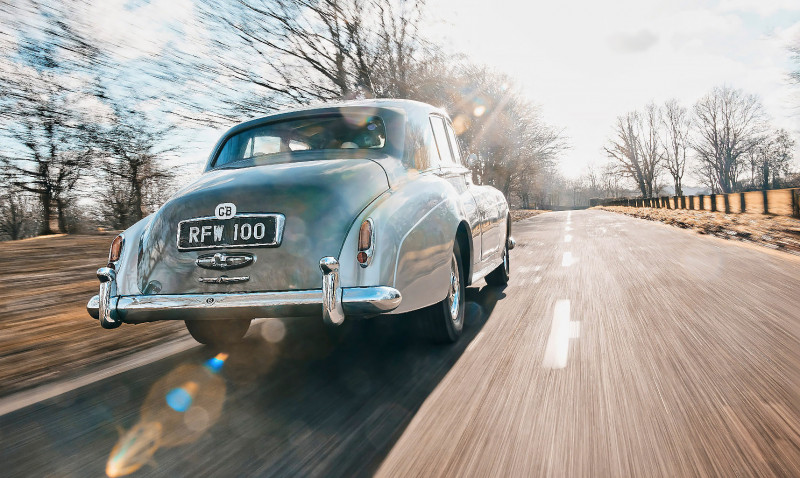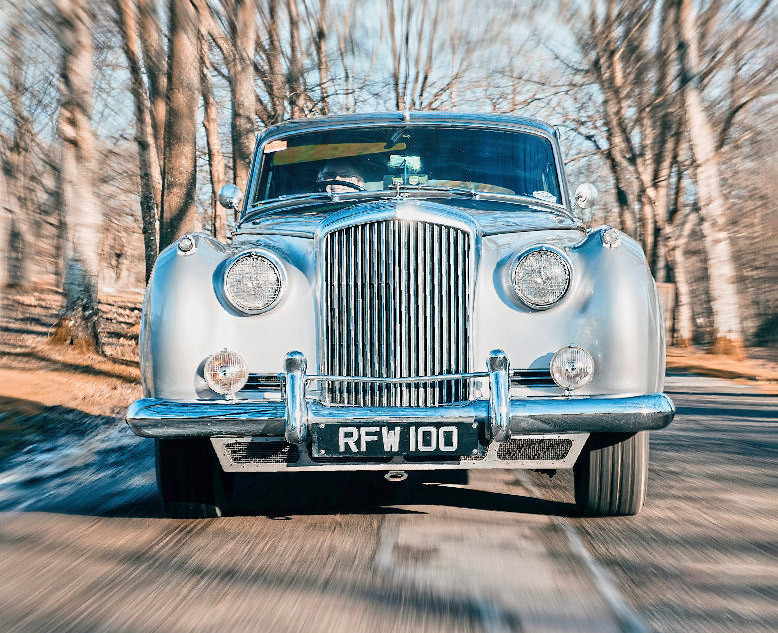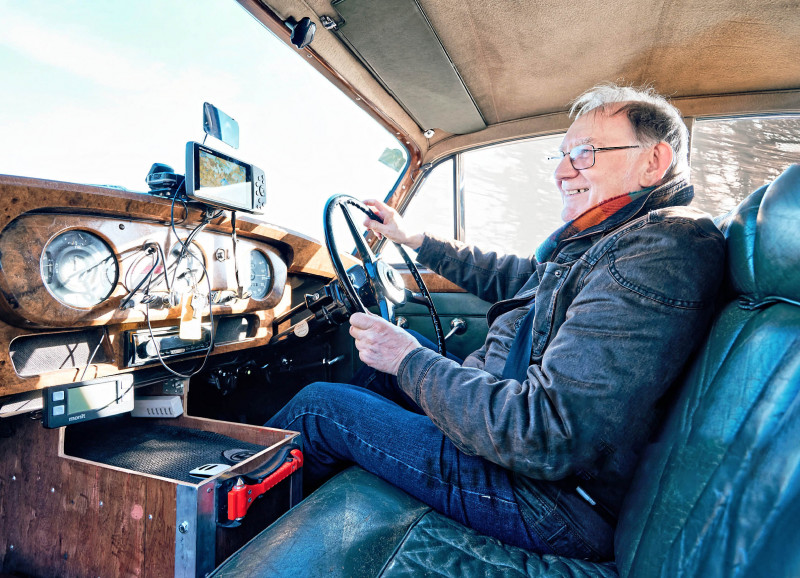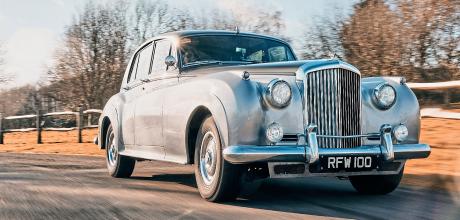1958 Bentley S-Series Saloon
Rolls-Royce owner and enthusiast John Waine has prized the best of British luxury since his youth. Today he’ll drive the model of his teenage dreams, the 1958 Bentley S-Series.
Words EMMA WOODCOCK
Photos SAM CHICK
Modern-classic
Rolls owner Waine tries out a distant ancestor: Bentley S
COVER The List Reader John Waine takes the wheel of a very well-travelled Bentley S series
John Waine cracks a grin as we motor past the 1958 Bentley S-Series parked on Tenterden High Street. ‘Oh, there it is!’ he says. Imposing even among the Kent town’s neo-classical mansions, and almost as large, the grey-over-silver saloon harks back to the era when John’s love of cars began. ‘I’ve been keen on the S-Series and its Rolls-Royce contemporary, the Silver Cloud, ever since the age of 12. I always promised myself I’d have one, if they fell within my financial reach! It’s a matter of some regret that they never have.’ His feelings may be about to get much stronger. Today he’ll drive this magnificent motor. Not before he’s parked his own example of Crewe-built luxury, mind. Flecked with road grime from the morning’s motorway slog, the sumptuous 1981 Rolls-Royce Silver Spirit has come along by way of a direct cross-generational comparison.


‘Exactly what a standard-steel Bentley ought to be’
‘It’s just a little more appropriate than my ratty old Saab 9-3 daily,’ he laughs. ‘I’m glad of the opportunity to go straight from one to the other. What better way to discern the differences in ride and handling between my Spirit’s unitary construction and the separate chassis approach, or to contrast the profile of the six-cylinder B-Series with the eight-cylinder I know so well?’ Ejected from the comforting swathes of modern classic leather and walnut, we take the short walk back to the town centre in the company of Doug McWilliams. The mercury is well below zero and a treacherous combination of snow and ice hides in shadier corners, but the S-Series owner is not concerned. Both man and machine have faced far worse – Doug and his brother Mike bought the Bentley with the express intention of tackling the epic Peking to Paris rally. ‘Our father had one when we were growing up, so we thought it’d be fun use one on the event.

‘I always promised myself I’d have one, if they fell within my financial reach!’
We found ours for £20,000, fitted up with curious glassfibre wings.’ In 2019, joining 106 other competitors, they achieved their goal. The pair set out from Beijing on a five-week adventure that traversed the Gobi desert, Siberia and – for the first time – Kazakhstan before ribboning across Europe to the finish. By the time the Bentley rolled into Paris, the brothers had covered about 9400 miles and could claim to be one of just 21 crews to complete the rally distance entirely under their own steam.
An economist by trade, Doug then wrote a book about the car, the adventure and what it had shown him first-hand about the world’s shifting fiscal centres.
‘It’s an unexpected bonus,’ says John. ‘Knowing I’m about to drive a car that’s successfully completed one of the most arduous rallies available highlights the Bentley’s good design and basic strength. If anything, the additions bolster the experience – the home-made centre console loaded with tools and the super-duper satnav that works way out in the desert, with all its complicated wiring! They’re remarkable features; I’m glad Doug chose to keep them. Each one forms part of the car’s character without being likely to affect the driving experience. ‘I’m struck as much by the similarities to my Silver Spirit, not least the beautiful upholstery of the leather seats and the veneer that covers the dashboard. The seating stands several inches higher in the Bentley, which is quite something when I consider that the driving position of my car is already lofty by any modern standards. The S-Series wood is notably less plain, but there’s a feeling of solidity and huge comfort that links the two cars.’ He reaches up and twists the ignition key, then pulls carefully away. ‘Mounting the key in the centre of the dash is a classic piece of Rolls-Royce design that dates back to the vintage era, and the pull-and-twist T-bar handbrake makes a real change from the Spirit’s pedal-operated system, but every other touchpoint feels immediately familiar. The slimness of the steering wheel, the absence of a rev counter and the positioning of the gear selector on the steering column all foreshadow my car.’

As John arcs around and aims the Flying B west, out of town, driving differences begin to show the two-and-a-bit decades between the two models. ‘It doesn’t creep forwards when I take my foot off the brake. I have to give the Bentley a little gas to get moving in drive, unlike my car. The power-assisted steering is markedly heavier too, though that’s fine. Turning this very large wheel, the weight and the sensation remind me more of my first car, a 1955 Riley RME. It very much feels of that era.’
‘I’ve always been led to believe, by various things I’ve read over the years, that the steering on these older Royces and Bentleys was a bit imprecise,’ he says as the traffic drops away, our pace rises and we glide towards rural Rolvenden. ‘But this car doesn’t feel the least bit vague. Slaloming around these traffic cones, it just feels like everything is where it needs to be.’ Leaning forward from his back bench perch, Doug is quick to offer a possible explanation. ‘When we reached Novosibirsk in Russia, the offside front wheel was all but falling off. We’d broken the steering pin, so we gave the scrap to a local guy who fabricated us a new part from scratch. Since getting home, we’ve renewed the entire system from the wheel back, so there’s not a part in the steering today more than three years old.’

‘That can’t hurt, but I don’t think it’s a question of component age,’ John muses. ‘I feel that it’s an endorsement of the underlying technology. The steering response is direct, much more direct than I imagined, and the extra weight I’ve noticed is not to its detriment. The system never feels unduly heavy, or difficult to drive even at walking pace, and I’ve got all the feedback from the road I need to enjoy myself. I feel confident, the car feels secure and it goes just where I ask. It’s a delight.’ Subtly modified suspension might be adding to that sense of precision. After stripping out the robust and raised ‘colonial specification’ springs and damping used for the round-world rally, Doug’s car got a Harvey Bailey handling kit that evokes Bentley’s sportier Continental models. ‘The chassis feels really tight and not at all heavy or cumbersome, quite unlike other large Fifties saloons, and belies the two-ton kerbweight. I was expecting a slightly sloppy drive, but the suspension feels harder than my Spirit yet still manages to soak up every last pothole.’
‘I’m sure I could drive a fair bit faster,’ he adds. ‘I’m already quite comfortable with everything it’s doing.’ A few miles later, we trade knotty backroads for the straighter tarmac of the A21 and he gets his wish. ‘How superb! There’s space here to climb up to 60mph and I’m discovering that the S-Series is still a respectable performer. It’s not as accelerative as the later V8- engined models, but the straight-six is smoother and somewhat silkier. Quieter too! The older engine is the more refined, which is a pleasant surprise. I thought the opposite would be true.’ ‘The transmission works very well with the engine; gearshifts aren’t noticeable. The much more modern Hydra-Matic variant in my Silver Spirit is smoother, but there isn’t much in it.’ A larger generational gap reveals itself when our turn-off looms and he pushes the brake pedal. ‘The drum brakes aren’t as fierce as the discs Bentley and Royce adopted from the late Seventies. I’m having to press the pedal harder and the response isn’t quite so fierce, though they’re still perfectly capable for their era. Rolls-Royce was rightly proud of its mechanical servo.’ Doug adds his view from the rear. ‘We didn’t upgrade the brakes for the rally – there was no need.’
‘This is a superb car,’ John adds. ‘The all-round performance is very good, elevating the S-Series from being simply a luxurious gentleman’s carriage to a car with a degree of sportiness that’s fully deserving of the Bentley badge. I’ve been driving reasonably swiftly and remain in such supreme comfort that I’m confident I could stay at the wheel all day without fatigue. It’s even a good driver’s car; I’m having a lot of fun with it.’ He brings the Bentley to a halt, to investigate what lies beneath the bonnet’s centre hinges. ‘It’s a very good-looking engine and it shows off far more of its individual components than does the Silver Spirit, with plenty of space around it. And even now, at tickover, it seems inherently hushed, which is what I’d want it to be. When I first promised myself I’d have an S-Series or Silver Cloud of my own, it was going to be one of then-contemporary models with the new V8 engine. As a result of today, I’d seriously consider going for the six-cylinder instead.’
What hasn’t changed is his adoration of the S-Series styling. ‘I think it’s the best of Bentley and Rolls-Royce’s own post-war design – the perfect saloon. Neither company has produced anything as good since. The proportions of its classic three-box outline look so right, so balanced, that one never realises just how large a car it is until one’s standing alongside it. Pretty much all the two-tone liveries enhance its elegance, but the particular contrast between very dark grey and the underlying silvery tone render Doug’s example particularly, classically gorgeous. ‘This is a magnificent motor car – I’ve liked it from the moment I first climbed aboard.’ John is smiling wide as he motors his final mile with the S-Series. ‘I can’t pick a winning aspect or favourite moment. It’s the magnificence, the whole superb ambience, that appeals. I’d say the same of my Silver Spirit, and it’s been interesting to discover how slight the differences between the generations are, with the older model encapsulating its period and my car carrying that tradition forwards.
‘If I were forced to choose one, though, I’d have to pick the S-Series for its comfort, its looks and its elegance. It’s still in my top ten, without a doubt.’
Beneath stately looks lies a fine driver’s car, says our reader
TECHNICAL DATA 1958 Bentley S-Series Saloon
- Engine 4887cc inline-six, pushrod inlet OHV and side exit exhaust valves, twin SU HD8 carburettors
- Max Power and Torque Undisclosed
- Transmission Four-speed GM Hydra-Matic automatic with over-ride, rear-wheel drive
- Steering Cam and roller, power-assisted
- Suspension Front: independent by wishbones with coil springs, Rolls-Royce hydraulic dampers and anti-roll bar. Rear: live axle with semi-elliptic leaf springs, Rolls-Royce hydraulic dampers with electronic control
- Brakes Servo-assisted. Front: hydraulic drums, rear: hydraulic and mechanical drums
- Performance Top speed: 103mph;
- Acceleration 0-60mph: 13.1 sec
- Kerb Weight 2032kg (4480lb)
- Fuel consumption 13.6mpg
- Cost new £6305 inc
- Purchase Tax (1957 model year)
- Classic Cars Price Guide £17,000-£42,500
‘The straight-six is smoother and silkier than the later V8 models’ John was very impressed by the hushed straight six Centre-hinged bonnet hides refined inlet-over- exhaust six
John found the S-Series’ cabin a quite delightful place to be. Brake pedal gives progressive stopping.
Home-made centre console was for Peking- Paris Rally


